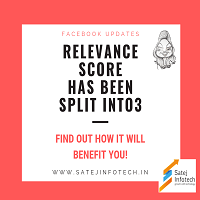Facebook Updates-Relevance Score
Relevance Score Cut in Three
Yes you heard me right!
For a very long time, the relevance score has been a single number (and one that advertisers use heavily). In case you haven’t used it yourself, this one number would be a great indication of predicted success and the estimated quality of ads. What’s more, it had a direct interaction with CPCs and ROI.
Rather than just one relevance score, Facebook has announced that we will soon have three different metrics. Described as ‘Granular Ad relevance diagnostics metrics’, it sounds incredibly fancy but they’re actually very simple matrix.

Engagement Rate Ranking
When compared with ads that are targeting a very similar audience, how will your ad rate in terms of engagement? Will it perform better, or will it be worse or is it the same as your competition?
With this simple piece of information, you can adjust your ads and constantly compare your own ads with the competition to see what works and what doesn’t.
Quality Ranking
In this matrix the perceived quality of your ad is the main metric. As a comparative metric, it won’t be in your control as such, but it can be useful to see where you are in the market with regards to quality and whether you can improve it.
Conversion Rate Ranking
Finally, we all want a high conversion rate, right?
If you’ve ever wondered how your conversion rate compared with similar ads in your niche, this is your chance. Although only an ‘expected’ conversion rate, you’ll be provided with a ranking alongside those with the same audience and optimization goal.
Has anything else changed? Well, the algorithms on Facebook are still critical and you probably noticed that all three metrics make predictions, and this means these rankings can change as the campaign progresses.
It’s time to discuss if this change is positive or negative?
Immediately, you might feel a little stressed because you now have to pay attention to more data than you are used to.
But on the contrary, splitting the relevance score into three will allow for detailed feedback.
As time goes on, you’ll be able to use this matrix to improve your campaigns and becoming a more effective advertiser.
Rather than being confused why a campaign with lots of engagement is only showing a relevance score of ‘5’, you can see what’s not quite going right.
Instantly, potential issues are highlighted, and you know where to focus your attention to improve results.

